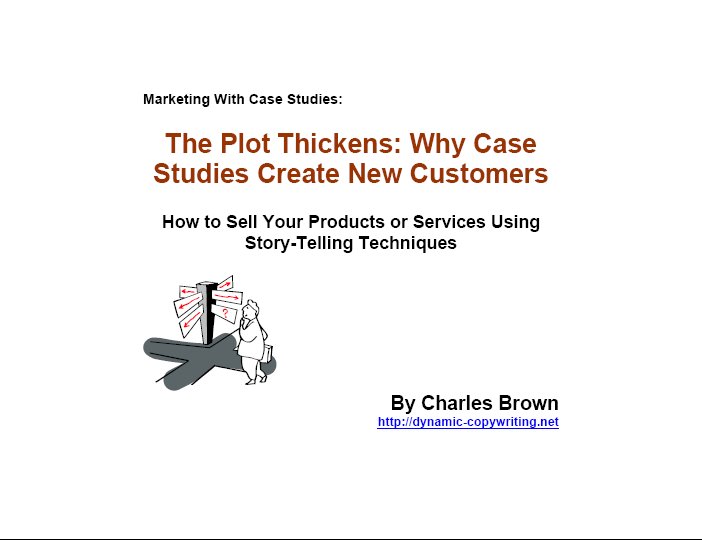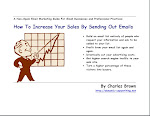Get More Search Engine Traffic With Mini Sites
0 comments Posted by Charles Brown at Monday, September 29, 2008It is no secret that one of the most effective ways to optimize a website is to include your targeted keyword in your site's domain name. For example, if one of your business' targeted keywords is "accounting software," you may want to have www.accountingsoftwaresolutions.com as your domain (by the way, I just checked and this URL has expired so you could grab it now if you are quick enough).
Unfortunately, most of us do not have the luxury of re-naming our websites just to target one keyword, no matter how valuable that specific keyword may be. Most businesses either already have a website or they must target other keywords.
But if I were in the accounting software business, I would still be very interested in grabbing such a domain name because there has to be a lot of people who log into Google and type in "accounting software" as their query.
The solution, is to set up mini-sites, or as a recent article on Dosh Dosh calls them, "Mini-Funnel" Websites. These Mini Funnel sites are actually "slave sites" that exist to answer a single, specific question and feed search engine traffic to a master site.
They get searchers because these mini sites are set up to grab one keyword and then re-direct these visitors to another site that may target many other –related- keywords.
Maki (the author of the Dosh Dosh article) uses an interesting example a site called, Is Barack Obama a Muslim. This site is a one-page site that has the word "NO" printed in big black letters against a stark white background. Visitors who click the word "NO" are directed to an article on www.barackobama.com that addresses smear email campaigns.
The article, How ‘Mini-Funnel’ Websites Can Help You Increase Traffic, Generate Leads and Build Exposure, also points out an interesting twist. The Obama team has also set up companion mini-funnel sites that offer different phrases and even allow for misspellings by searchers.
For example, the site Is Barack Obama Muslim, which leaves out the word "a," has produced even better results than the previous example:
"This particular one ranks the highest on both Yahoo and Google for the ‘is barack obama muslim‘ phrase, taking the no. 1 spot and even outranking Obama’s own official website. This appears to be the most established version of the three; Yahoo site explorer shows that it has 10,762 incoming links."
There is even a version of the site that uses the word "muslin" instead of "Muslim," to accommodate people who may misspell the word when they type in their search engine query.
The lesson here is that mini sites, which target single keywords, can drive massive traffic to your main website. Look for search terms related to your business and set up one-page sites that answer the visitor's question and then provide a link for more information to your main site.
This will allow you to benefit from traffic coming in from many, many different search terms.
COPYRIGHT © 2008, Charles Brown
Labels: long tail search terms, seo writing
What's Going On At Kadient, Inc.? - A Success Story About Knowing Your Customers
1 comments Posted by Charles Brown at Friday, September 19, 2008I recently had the pleasure of interviewing Heather Margolis, Director of Marketing, and Yoshi Watanabe, Principle Software Engineer, of Kadient, Inc. Kadient has already been the topic of two previous blog posts I've written, but I was so impressed by how they go about doing business that I asked if I could interview them by telephone.
Kadient makes sales coaching and enablement software that makes the lives of salespeople easier by giving them the content they need, when they need it, depending upon the situation they are in.
One of the constant problems sales executives experience is that their sales people often don't actually use sales support software provided by their companies. If they perceive that the program is too awkward, too hard to learn or gets in the way of actually making sales, most employees will stop using software and go back to doing things the old way.
Mr. Watanabe spoke about how the company in general, and the development teams in particular, underwent a paradigm shift that is unique among technical companies. Traditionally the emphasis is on product excellence. The thinking is that if a company makes the very best, most technically advanced product, the market will come to them.
He said, "It is not uncommon for developers to create products with no idea of how it is used and who is using it and what problems they are having."
This, of course, made me think of the old expression, "Build a better mousetrap, and the world will beat a path to your door." Perhaps this is a great idea in principle, but it ignores the reality of marketing and the necessity to open up two-way communications with customers. It also begs the question of whether the mousetrap is better in just its creators' eyes or in the eyes of those people who are intended to use it.
Mr. Watanabe describes how Kadient's paradigm shift began. "We asked ourselves: Ok we've built our software (the first version). Does it really help the users solve their problems? And after getting feedback from users, we had to admit that the answer was no. It was confusing and cumbersome to the users and didn’t solve some of their major painpoints."
The system, they realized, was the center of their focus – not the end users' needs.
So Kadient shifted their thinking from just product development to "User Stories." They brought together people who had daily contact with actual customers and users, product managers, developers and the marketing team for a two and a half day session.
Everyone who represented users and had contact with them were given index cards to describe what users wanted, not just when it came to the product, but also in day to day life. For instance, a sales rep is working with 20 prospects at a time and may not remember every status. They may also be a young professional always on the go and needs things to be quick and easy.. At the end of the session they had produced 100s of index cards with statements about what their users wanted.
These wants, of course, were then shown to actual customers, users and buyers within the companies they serviced for further refinement.
This led to an understanding that some users wanted some things while other users wanted different things. With this understanding, Kadient created several different "buyer personas" to help them make each of these buyer needs more personal.
For example, one of their buyer personas is a sales rep named "Anya." Anya is a successful sales person for a financial services company who has been in the top 10% for the last five quarters. Her goal is to do less of her own administrative tasks and free herself to spend more face time with actual customers.
"Luke" on the other hand is a 25 year old with sales talent but is not achieving the company's expectations for him. He needs a system that will help him build a better pipeline of prospects and needs help understanding these prospects' needs.
Obviously, Kadient has many other buyer personas, but Anya and Luke illustrate how they have put effort into personalizing the needs and goals of two types of end users. But it is what Kadient does next that really seems to set them apart.
Ms. Margolis said, "We segment a market, but then we go a step further above and beyond."
In company meetings it is not uncommon to hear conversations that begin with, "What would Anya do?" or "What would Luke do?"
In other words, they don't think of their buyer personas as mere segments of their marketplace, they think of them as actual people. Composites of many similar users, but people nevertheless.
They have created life-sized cardboard cutouts of Anya and Luke that get moved around within Kadient's building. One day they can be in a conference room, another day in the lunch room, and another in someone's cubicle. The idea is to get to "know" Anya and Luke as if they were real people.
And it is not just the marketing people who are tuned in with these personas. "The thing that I am the most impressed with is how the engineering and product development people have embraced the concept of buyer personas and user personas. It makes our sales, marketing and development teams much more in-tuned with each other," said Ms. Margolis.
So what kinds of results have these ideas delivered? The day before our conversation, Ms. Margolis was interviewing a buyer with one of their customer companies. This customer will save $500,000 that couldn't have been realized if the product wasn't actually being used.
The feedback she gave Ms. Margolis was that, "They employees keep talking about how easy Kadient's software is to use."
Perhaps that is the greatest testament Kadient could have had.
COPYRIGHT © 2008, Charles Brown Add to Onlywire
New Ebook For Small Business Owners and Professional Practices
0 comments Posted by Charles Brown at Monday, September 08, 2008I just posted a new ebook I've been working on for small business owners and professionals who need to increase sales or attract new clients.
This new ebook is free and can be downloaded at How To Increase Your Sales With Non-Spam Email Marketing.
I've done a lot of work with lawyers and law firms, as well as "brick and mortor" small business owners, and have seen them spending an inordinate amount of money on useless advertising that produces disappointing results. In response, How To Increase Your Sales With Non-Spam Email Marketing was written to give them the tools of Permission Marketing, email marketing, information products, direct response advertising and direct response web sites.
I absolutely believe that almost all businesses can double their sales using these marketing tools.
So if you are a small business owner or professional who wants to attract more business, be sure to download your free copy. Using these methods, you really can double your sales - and I can prove it.
COPYRIGHT © 2008, Charles Brown Add to Onlywire
As I listened to Hillary Clinton's speech last week in the Democratic Convention (I know, I have been drawing a lot of marketing lessons from the presidential race, but I promise not to turn this into a political blog), I was struck by how often she weaved "case studies" into her speech.
She talked about a single mom who had adopted two children with disabilities and then lost her job. She also talked about a young marine who was worried about his buddies who were still over in Iraq. And she talked about people who were worried about getting needed healthcare for their families.
I've noticed that Mrs. Clinton has done this often over the course of this campaign. The people she talks about are real people she has met along the campaign trail.
Ronald Reagan did this too. Many of his speeches were laced with stories about actual people who were facing incredible challenges.
And you have to admit that regardless of your political persuasions, the use of these "case studies" makes for effective communications.
Now let me tell you the wrong way to do this. There is a personal injury lawyer who advertises extensively here in the Dallas / Fort Worth area. Imagine the most annoying, most grating lawyer ads you've ever heard. Well this guy is worse.
He calls himself "The Texas Hammer" and he promises to "fight for you to get you the money you need." (Sigh).
Anyway, he also lists some of the recent cases he has one. Well actually he lists the dollar amounts of the awards he has won. He tells very little about the clients themselves as human beings. He might say they injured their leg or wrist or whatever, but no information about them as people that would make us sympathize with them or relate to them.
In other words, they are presented as dollar figures, not as people who were helped out of a difficult problem.
Don't make this mistake.
I've seen a lot of case studies that do the same thing. The subjects are presented as cardboard, lifeless characters who are little more than extras in their own movie.
But readers want to connect with the people they are reading about. Allow readers to experience the emotions and problems of your case studies subjects. Delve into their fears, the raw emotional nerves of their troubles. THEN when you show how they escaped from these problems, the reader will cheer for their happy ending as they would for a dramatic movie.
Hillary won 18 million votes, and I have to wonder if a lot of them were a result of her ability to tell compelling stories about our fellow citizens. And if it works in politics, it will also work in business.
COPYRIGHT © 2008, Charles Brown Add to Onlywire
Labels: case studies, storytelling


